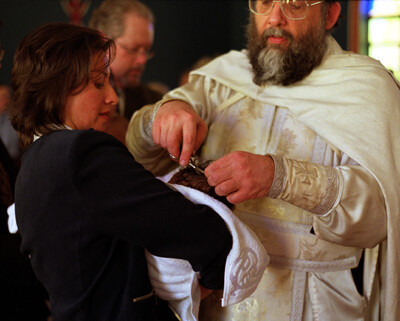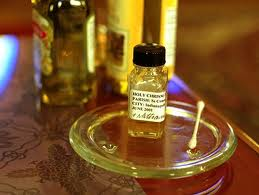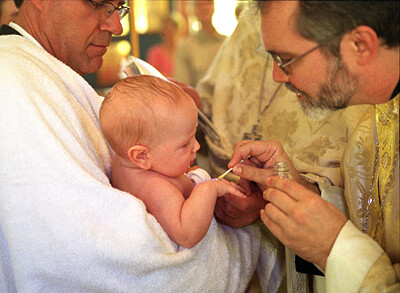Holy Chrismation
|
The Sacrament of Chrismation awakens in the soul that inner, spiritual thirst which does not let one grow satisfied solely with the earthly and material, but always summons us to the Heavenly, to the eternal and the perfect. It makes the baptized person the possessor of the Spirit bearing beauty and a partaker of sanctity, of the Unwaning Light and Divine Life. It is for this reason that in Chrismation the new member of the Church not only receives the Spirit within, but is outwardly encompassed by Him, being robed henceforth as if in special spiritual garments.
The prayer to God for the bestowing of the Holy Spirit, which precedes the anointing, and the anointing itself of certain parts of the body crosswise with the Chrism, accompanied by the words, The seal of the gift of the Holy Spirit, Amen, have always comprised the basis for the Office of this Sacrament. It concludes the grace-giving process of the new member's joining the Church, making him an equal among the faithful and rendering him worthy, henceforth, to partake of the Body and Blood of Christ. Originally the Apostles conferred the Holy Spirit on those who gladly received the Word of the Gospel (Acts 2:41) and were baptized through prayer and the laying-on of hands. In the Acts of the Apostles, Peter and John were sent to the Samaritans who had received the word of God and they prayed for them that they might receive the Holy Spirit.... Then they laid their hands on them and they received the Holy Spirit (Acts 8:15, 17). The need to administer the Sacrament of the spirit through the laying-on of hands required the personal participation of the Apostles, but later they blessed the Bishops and Presbyter whom they consecrated to conduct the invocation of the Holy Spirit upon believers through anointing them with the Holy Chrism, and permitted Bishops alone to consecrate the Chrism. As St. Cyril of Jerusalem says, Holy Chrism...is a gift of Christ and of the Holy Spirit, which is validated by the presence of His Divinity.... And when the body is anointed in a visible fashion, the soul is consecrated with the Holy and Life-Giving Spirit. The Chrism here used consists of olive oil, to which has been added white grape wine and a number of aromatic substances symbolizing the various grace-bestowing gifts of the Holy Spirit conferred through Chrismation. The Holy Chrism, which has been prepared at the beginning of Holy Week, is formally consecrated, usually by the Primate of the Church, on Holy Thursday and then distributed to the Bishops who, in turn, distribute it, as needed, to the Priests, for use in the Sacraments.  In the Office of the Sacrament of Chrismation, the anointing is performed with the recitation of the words, The Seal of the Gift of the Holy Spirit, during which the Priest anoints crosswise with the Holy Chrism the forehead, eyes, nostrils, mouth, ears, breast, hands and feet of the Newly-illumined. After the anointing, the Priest then leads the Newly-illumined and sponsor (s) three times around the font to the singing of As many as have been baptized into Christ have put on Christ. Alleluia! This circular procession is seen as a symbol of joy. Then follows the reading of the Epistle and Gospel which (along with the preceding hymn) refer to Baptism, since, from antiquity, the two Sacraments have been linked into one rite. After this, the Chrism is washed off and the white baptismal garments removed. [In ancient times this was customarily done on the 8th Day after, i.e., St. Thomas Sunday.] The hair is then cut in a crosswise manner The Tonsure as a sign of humility and readiness for sacrificial service to the Lord an initiation into the Army of Christ. |
Excerpt taken from "These Truths We Hold - The Holy Orthodox Church: Her Life and Teachings". Compiled and Edited by A Monk of St. Tikhon's Monastery. Copyright 1986 by the St. Tikhon's Seminary Press, South Canaan, Pennsylvania 18459. |

 In the Sacrament of Baptism man is called out of spiritual darkness into the light of Christ and is initiated into the economy of salvation by the Son of God. This initiation is effected, however, in the Sacrament of Chrismation. Repent, and be baptized every one of you in the Name of Jesus Christ, the Apostle Peter preached to the people on Pentecost, and you shall receive the gift of the Holy Spirit (Acts 2:38). Since that time the Divine Gift of the Holy Spirit is bestowed upon each person who rises from the baptismal font. And everything the Holy Spirit touches receives the seal of an invaluable treasure, a ray of eternal light, the reflection of Divine action.
In the Sacrament of Baptism man is called out of spiritual darkness into the light of Christ and is initiated into the economy of salvation by the Son of God. This initiation is effected, however, in the Sacrament of Chrismation. Repent, and be baptized every one of you in the Name of Jesus Christ, the Apostle Peter preached to the people on Pentecost, and you shall receive the gift of the Holy Spirit (Acts 2:38). Since that time the Divine Gift of the Holy Spirit is bestowed upon each person who rises from the baptismal font. And everything the Holy Spirit touches receives the seal of an invaluable treasure, a ray of eternal light, the reflection of Divine action. The Prayer at Anointing with the Holy Chrism contains an assertion that the one who has been graced to receive the seal of the Gift of the Holy Spirit receives aid to remain indomitable, unchanging, unharmed, untouched, unoppressed, safe from the designs of the Evil One, to abide in the Faith and to await the heavenly rewards of life and the eternal promises of our Lord and Savior Jesus Christ. Such a lofty gift of the Holy Spirit, bestowed in Chrismation, obliges the person being anointed to remember constantly the words of St. Paul: Do you not know that you are God's temple and that God's Spirit dwells in you (1 Cor. 3:16)?
The Prayer at Anointing with the Holy Chrism contains an assertion that the one who has been graced to receive the seal of the Gift of the Holy Spirit receives aid to remain indomitable, unchanging, unharmed, untouched, unoppressed, safe from the designs of the Evil One, to abide in the Faith and to await the heavenly rewards of life and the eternal promises of our Lord and Savior Jesus Christ. Such a lofty gift of the Holy Spirit, bestowed in Chrismation, obliges the person being anointed to remember constantly the words of St. Paul: Do you not know that you are God's temple and that God's Spirit dwells in you (1 Cor. 3:16)?



